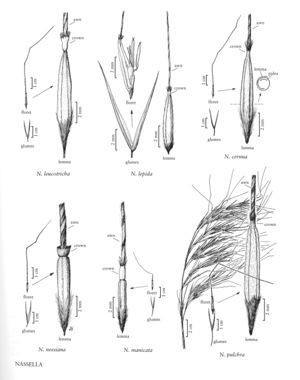Nassella leucotricha
Plants perennial; cespitose, not rhizomatous. Culms 33-120 cm tall, 1-1.2 mm thick, erect, internodes glabrous; nodes 3-5, usually pubescent. Sheaths often conspicuously hairy, sometimes glabrous, basal leaf-sheaths often with cleistogenes; collars glabrous, often brown or purple-tinged, with tufts of hair at the sides, hairs 0.5-1 mm; Iigules 0.2-1.2 mm, glabrous, truncate, sometimes longest at the sides; blades 10-35 cm long, 1-3.6 mm wide, flat to convolute, abaxial surfaces sparsely coarsely hairy, adaxial surfaces glabrous. Terminal panicles 5-55 cm, open; branches 3-7 cm, ascending or spreading, angled, scabrous, glabrous or hairy, with 1-4 spikelets; pedicels 4-9 mm. Glumes subequal, 10-21 mm long, 0.7-3.2 mm wide, narrowly lanceolate, glabrous, 3-5-veined; florets 6.5-13 mm long, 1.1-1.4 mm wide, terete, widest near or slightly above midlength; calluses 1-5.5 mm, sharp, strigose; lemmas straw-colored to light-brown, papillose distally, constricted below the crown, veins pubescent proximally, particularly the midveins, glabrous between the veins; crowns 0.75-2 mm, usually longer than wide, often flaring distally, rims irregular, with 1-2 mm hairs; awns 40-90 mm, clearly twice-geniculate, terminal segment straight; anthers 3 and 3.5-5 mm in chasmogamous florets, 1-3 and shorter than 0.7 mm in cleistogamous florets. Caryopses about 4 mm. 2n = 28.
Distribution
S.C., Ark., Okla., Tex., La.
Discussion
The range of Nassella leucotricha extends from the southern United States, where it was once one of the dominant species, into northern Mexico. It is now established in Australia (Jacobs et al. 1995). In North America, N. leucotricha grows mostly in open grasslands, but it is also found in woodlands. It provides good spring forage and increases in abundance with moderate grazing, primarily because of its cleistogenes. It resembles N. manicata, but has longer florets and less strongly developed crowns.
The sharp callus easily sticks to skin and clothing, and can cause wounds, especially in the mouths of grazing animals. The wounds often retain the fruit, which may require surgical removal for proper healing.
Individual plants produce both chasmogamous and cleistogamous florets in their terminal panicles, with the terminal florets usually being cleistogamous. The proportion of cleistogamous florets is influenced by soil moisture, a higher proportion being produced if the soil moisture content is low (Brown 1952). Spikelets of the axillary panicles usually mature before those of the terminal panicles (Dyksterhuis 1949).
Selected References
None.
Lower Taxa
"decumbent" is not a number.
